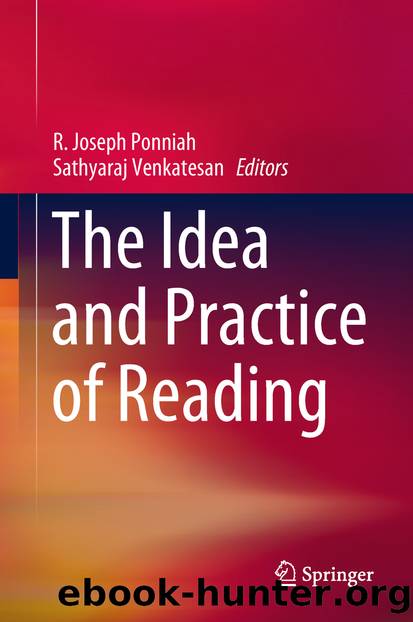The Idea and Practice of Reading by R. Joseph Ponniah & Sathyaraj Venkatesan

Author:R. Joseph Ponniah & Sathyaraj Venkatesan
Language: eng
Format: epub
Publisher: Springer Singapore, Singapore
Indian Research Studies on Strategy Instruction
The first study, by Jose (2000), aims to make learners more independent in reading by generating awareness of reading strategies. She argues for a learner-chosen strategy training programme. Twenty adult ESL learners (graduates and postgraduates) who joined an English proficiency course in the Central Institute of English and Foreign Languages, Hyderabad participated in this study. Results showed that an awareness of and exposure to alternative strategies such as active reading strategies (chiefly strategies to get the meaning of unfamiliar vocabulary), comprehension monitoring strategies and metacognitive strategies (summarizing and self-evaluation) led to enhanced reading comprehension, manifested in improved task performance. As a result of learners’ increased strategy repertoire, the readers also gained confidence and attempted independent reading.
Kaw (2006) attempted to find the role played by questioning in the teaching of reading comprehension in ESL classrooms. Her study provided an empirical justification for the use of questions in teaching second-language reading. Question-rich teaching sessions were conducted for a stipulated period of time to find out whether persistent questioning helps in making learners autonomous. The teaching sessions were based on question–answer exchanges with questions that were cognitively varied. In the feedback sessions, instead of giving away the correct answers to questions, the teacher posed further questions with the aim of simplifying the questions, helping the learners to understand the focus of the question and directing their attention to the textual clues that hold the correct answer.
The subjects for this study were 29 Class VIII students studying English as a second language in a Kendriya Vidyalaya, Hyderabad, Telangana. The findings of the study showed that the children copied answers (from the textbook) much less in the post-intervention test. It also showed that allowing learners to discover answers for themselves was beneficial as it helped them to grow autonomous and self-reliant in getting the meaning out of a text which meant that their cognitive problems in processing textual information had decreased.
Rajasekhar (2006) chose to work with three specific strategies—imagination, elaboration, prediction and confirmation (IEPC), semantic impression and mind modelling—to teach a group of Class 7, 8 and 9 students studying in a Navodaya Vidyalaya, Peddapuram, East Godavari district, Andhra Pradesh. As a result of the teaching, his students participated actively in class, became more articulate and responded to questions more confidently. The study does not document a pre- and post-intervention test but does claim that their comprehension abilities had increased. This claim is based only on teacher plausibility and in-class ongoing evaluation.
A critical look at both Indian and non-Indian studies reveals that the nature of the two languages that feature in them plays an important part. Two of the six studies dealt specifically with non-cognate languages, English and Japanese, and Afrikaans/Setswana and English. One study had a range of first languages but focused on English as a second or foreign language. The others all dealt with cognate languages. Cognitive strategies may transfer across non-cognate languages with ease, but it is possible that comprehension strategies need deliberate and focused instruction, when the distance across the two languages is vast and the script is also different.
Download
This site does not store any files on its server. We only index and link to content provided by other sites. Please contact the content providers to delete copyright contents if any and email us, we'll remove relevant links or contents immediately.
The Art of Coaching Workbook by Elena Aguilar(48031)
Trainspotting by Irvine Welsh(20042)
Twilight of the Idols With the Antichrist and Ecce Homo by Friedrich Nietzsche(17702)
Fangirl by Rainbow Rowell(7825)
Periodization Training for Sports by Tudor Bompa(7322)
Change Your Questions, Change Your Life by Marilee Adams(6635)
This Is How You Lose Her by Junot Diaz(5753)
Grit by Angela Duckworth(4728)
Red Sparrow by Jason Matthews(4654)
Asking the Right Questions: A Guide to Critical Thinking by M. Neil Browne & Stuart M. Keeley(4564)
Paper Towns by Green John(4163)
Room 212 by Kate Stewart(4099)
Ken Follett - World without end by Ken Follett(3968)
The Sports Rules Book by Human Kinetics(3581)
Housekeeping by Marilynne Robinson(3395)
The Motorcycle Diaries by Ernesto Che Guevara(3325)
Introduction to Kinesiology by Shirl J. Hoffman(3297)
Exercise Technique Manual for Resistance Training by National Strength & Conditioning Association(3285)
Double Down (Diary of a Wimpy Kid Book 11) by Jeff Kinney(3266)
